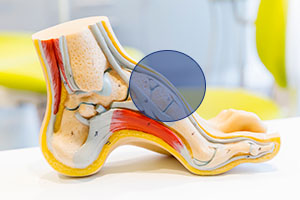
Midfoot
Arthrodesis
Arthritis, severe bunions, fractures and flatfoot can cause the middle of the foot to experience significant pain and reduce mobility.
Dr Alexander performs a procedure known as midfoot arthrodesis or midfoot fusion surgery to fuse bones and joints in the midfoot to alleviate discomfort and increase mobility.
Why is midfoot arthrodesis done?
The midfoot comprises bones and tendons that connect the forefoot, including the toes, to the hindfoot. These bones and joints behave differently from other joints in the body, as there is little movement and all that's required is a solid foundation to support the foot's function. It's for this reason that fusion occurs.
Midfoot arthrodesis can help improve mobility and eliminate the pain associated with arthritis and foot deformities. When the midfoot bones are fused, it restores the foot's natural stability and corrects deformities inhibiting movement.
When is midfoot arthrodesis necessary?
Dr Alexander performs midfoot arthrodesis in cases where a patient has severe arthritis, flatfoot, fractures or midfoot deformities that are causing discomfort and inhibiting mobility.
Other instances where this procedure may be necessary include increased movement of the joints, joint displacement, acute fractures and when other traditional methods have failed.
What happens during midfoot arthrodesis?
During the procedure, you will be placed under general anaesthesia, and your foot will receive a local anaesthetic to numb the area. Dr Alexander first makes an incision over the top of your foot to access the bones and joints. From here, he will remove damaged cartilage and any tendons or bone impacting your mobility. He then places a bone graft between separated bones to connect them and may use metal plates, screws and wires to restabilise the foot.
Dr Alexander will stitch the incision and dress the wound with sterile bandages. The entire procedure typically takes about 2 hours to complete.
Recovery after midfoot arthrodesis
Recovery from bone fusion includes several weeks of rest where you cannot apply pressure to your foot. Dr Alexander will provide you with a detailed guide for recovery and monitor your progress over several weeks.
After 2-3 weeks, your stitches may be removed, and you can transition to a cast. Dr Alexander will use X-rays to monitor your progress, and you can start to put weight on your foot after 6-12 weeks.
Contact Us
GIVE US A CALL:
CHAT ON WHATSAPP:
MAIL US:
LIFE GROENKLOOF HOSPITAL:
Room 104, Medical Centre West, 50 George Storrar Drive, Groenkloof
RASLOUW PRIVATE HOSPITAL:
Suite 105, Cnr R55 and Lochner avenue, Raslouw, Centurion

